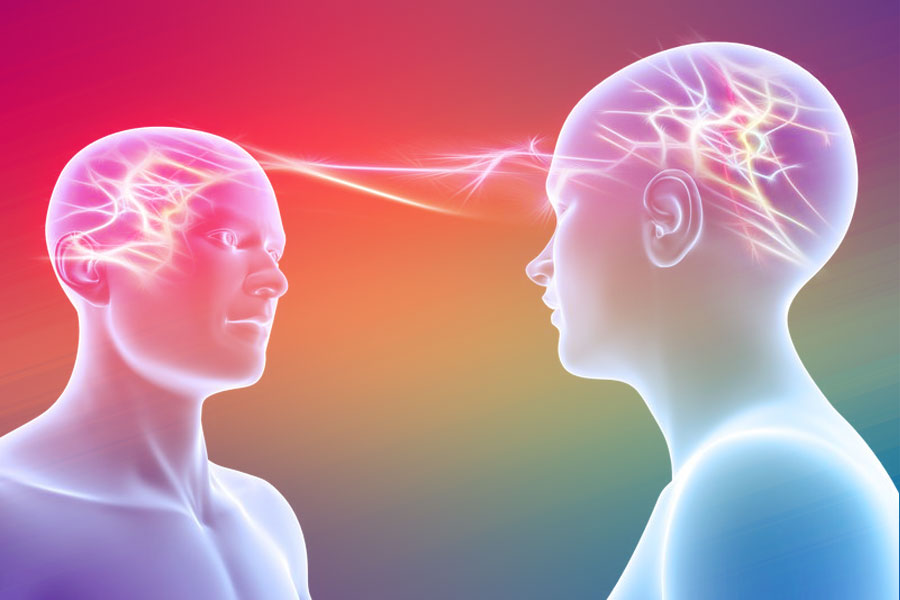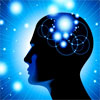Telepathy
 by Swami Panchadasi
by Swami Panchadasi
Telepathy, meaning Thought-Transference, bears a misleading title. Literally translated, it means “suffering at a distance,” or, perhaps, “feeling pain at a distance.” The name should really indicate “knowing at a distance,” in order to be properly descriptive. But as the term has acquired a forced meaning by reason of years of usage, it will probably be continued in popular favor. After all, names do not count, so long as the meaning is accepted and understood.
While the term itself has been generally used in the sense of conscious and deliberate sending and receiving of thought-waves, there is a far wider field of phenomena really covered by it, namely, the unconscious sending and receiving of mental and emotional vibrations.
There is a manifestation of energy or force (in the form of vibrations) in every mental or emotional state. This is true not only in the case of deep thought or vivid feeling, but also in the case of general mental “feelings,” and emotional states. During such manifestations there is a radiation of mental or emotional vibrations from the brain or nervous centers of the system, which flows out in all directions just as do light and wireless electricity. The principal seats or centers of these radiations are (1) the several brains of man, namely, the cerebrum, cerebellum, and the medulla oblongata, respectfully; and (2) the several great centers of nerve substance in the human system, called the plexi, such as the solar plexus, etc.
The vibrations arising from emotional excitement are sent out principally from the plexi, or great centers of the sympathetic nervous system. Those arising from the more strictly mental states emanate from certain centers and points of the brain, or brains, of the person manifesting them. Certain forms of these vibrations constitute the real essence of what is generally called “human magnetism.”
Firstly, every great plexus, or groups of nerve ganglia, in the human system is a receiving station, as well as a sending station. A person manifesting strong emotional excitement tends to awaken similar states in the nervous centers of other persons in whom the conditions are favorable. This explains why the vibrations of anger, fear, panic, are so contagious. It also explains the strong effect of the vibrations emanating from the nerve centers controlling the reproductive system, in certain cases of strong sexual excitation. Each human sympathetic nervous system contains many receiving stations where emotional vibrations are received, and where they tend to be transformed into similar feeling in the receiving system, unless neutralized by other mental and emotional states in the person.
When we come to consider the apparatus by which is received the vibrations arising from what may be called “purely mental” operations of the brain, such as intellectual thought, constructive imagination, etc., we find a more specialized arrangement, as might be expected. Although there are several minor receiving points, the principal apparatus for receiving thought vibrations of this kind is that which is known as the “pineal gland.”
The pineal gland is a peculiar mass of nervous substance which is embedded in the human brain, in a position near the middle of the skull almost directly above the extreme top of the spinal column. It is shaped like a small cone; and is of a reddish-gray color. It lies in front of the cerebellum, and is attached to the floor of the third ventricle of the brain. It contains a small quantity of peculiar particles of gritty, sand-like substance, which are sometimes called “brainsand.” It derives its scientific name from its shape, which, as I have said, resembles a pine cone. Physiologists are at sea regarding the function of this strange organ, and generally content themselves with the statement that “its functions are not understood.” But occultists know that the pineal gland, with its peculiar arrangement of nerve-cell corpuscles, and its tiny grains of “brain-sand,” is the physical telepathic receiving instrument. Students of wireless telegraphy have noticed a startling resemblance between the pineal gland and a part of the receiving instrument employed in wireless telegraphy.
The thought vibrations coming in contact with the nervous system of the receiving person, set up a peculiar vibration in the substance of the pineal gland and thus the first step in the transformation of these vibrations into thought-forms in the mind of the person is under way. The remainder of the process is too technical, both in the physiological as well as in the occult sense, to be taken up in detail at this time. The student will do well to get the idea of the workings of wireless telegraphy well fixed in his mind, for this will set up the right conception of the working of ordinary telepathy, without the necessity of complicated technical diagrams and descriptions.
And, now then, let us see what results from the sending forth and receiving of these mental and emotional waves of force and energy. In the first place, as all occultists know, each person is constantly surrounded with what has been called an “atmosphere” composed of mental and emotional vibrations which are emanated from his personality. The atmosphere of each person depends upon the general character of the thoughts and feelings of the person in question. Consequently, as no two persons are precisely alike in character, it follows that no two personal atmospheres are exactly alike. Each person has a psychic atmosphere of his or her own. These atmospheric vibrations do not extend very far from the presence of the person, and, consequently affect only those coming near to him.
In the same way, every group or crowd of persons has its own psychic atmosphere, composed of a blending of the individual psychic atmospheres of the persons composing the crowd, group or assemblage, and representing the general average of the thought and feelings of the crowd. There are no two group atmospheres exactly alike, for the reason that no two groups of persons, large or small, are exactly alike. Actors know that each audience which they face has its own psychic atmosphere, and the actors are affected by it. Preachers, lawyers, and speakers in general are quite aware of this fact, and freely admit it, though they may not be acquainted with the causes or laws governing the phenomena.
Following the same psychic law, it will be found that every town or large city, or even every small village or section of a larger town, will be found to have its own distinctive psychic atmosphere, which is very perceptible to strangers visiting the place, and which affect those who take up their residence in the place. In large cities, it has been noticed that every building has its own peculiar vibrations which arise from the general character of those occupying it. Different church buildings likewise reflect the character of the general habits of thought and feeling of those worshiping in them. Likewise, certain business streets have pleasant or unpleasant vibrations in their atmosphere, from the same causes. Every person recognizes the truth of these statements, though but few are able to account for the facts in a scientific manner.
The beginner in the study of psychic phenomena often asks how these things can be, when the thought which has occasioned the vibrations have long since passed away. The explanation is simple, when properly explained. It is something like this: just as heat remains in a room after the stove has ceased to throw out heatwaves, so do the vibrations of thought and feeling persist long after the thought or feeling has died away. Or, if you prefer a more material illustration, we may say that if a package of perfumery has been opened in a room, and then removed, the air will remain charged with the odor for a long time afterwards.
So, you see, the same principle applies in the case of psychic vibrations. The person carries around with him the general atmosphere of his characteristic mental and emotional vibrations. And, in the same way, the house, store, church, street, town, or city, etc., is permeated with the psychic vibrations of those who have frequented them. Nearly every one realizes the different feeling that impresses him when he enters a strange house, apartment, store or church. Each one has its own difference of psychic effect. And, so does each person create his or her psychic effect upon those coming in contact with him or her, or who comes into his or her presence or vicinity.
The next question asked by the thoughtful new student is this: If persons are constantly sending forth psychic vibrations, and if such vibrations persist for some time, why are we not overwhelmed with the force of them; and why are they not all so mixed up as to lose all their effect. I shall now answer this very important question.
In the first place, though we are constantly affected more or less by the multitude of psychic, vibrations beating upon us, still the greater part of them do not consciously impress us. For an example, we have but to consider how few of the sounds or sights of a busy street are impressed upon our consciousness. We hear and see only a few of the things which attract our attention and interest. The rest are lost to us, although our eyes and ears receive them all. In the same way, we are impressed only by the stronger vibrations which reach us, and then only by those which we have attracted to ourselves, or which prove attractive to us by reason of our own likes and dislikes.
In the second place, the effect of certain thought vibrations is neutralized by the effect of the vibrations of thoughts of an opposite character. Just as a mixture of black and white produces the neutral color of gray, so do two currents of opposing thought vibrations tend to resolve themselves into a neutral vibration which has little or no effect upon those coming in contact with them. You may think of numerous correspondences to this in the world of material things. For instance, a mixture of very hot and very cold water, will produce a neutral lukewarm liquid, neither hot nor cold. In the same way, two things of opposing taste characteristics, when blended, will produce a neutral taste having but little effect upon one. The principle is universal, and is readily understood.
In the third place, there is that which we may call an “affinity” between thoughts and feelings of a similar character. Not only do the vibrations of similar thoughts tend to coalesce and combine; but, more than this, each one of us attracts to himself or herself the thought vibrations which are in general accord with corresponding thoughts in our own minds, or feelings in our own nature. Like attracts like. In the same way, the character of our thoughts and feelings act to repel thought or emotional vibrations of an opposite or inharmonious nature. As all occultists know, everyone draws thought vibrations in harmony with his or her own; and also repels thought vibrations of an inharmonious nature.
We now come to the phase of what may be called direct telepathy—that is where a thought is consciously, and more or less purposely, directed toward another person. We come across many interesting cases of this kind where persons find themselves thinking intently of certain other persons, and afterwards are told by the other persons that “I found myself thinking intently about you, at such and such a time,” etc. In some of these cases it is difficult to determine which one started the thinking. Again, how often do we find ourselves thinking of a person, when all of a sudden the person comes into sight. Again, we think intently and earnestly about a certain question; and then, all of a sudden, other folks whom we meet begin talking to us about the same thing. These instances are too common to need more than a passing notice.
A little more purpose is displayed in that class of phenomena in which we intently wish that a certain person shall do a certain thing, and lo! we soon learn that that certain person has done it. A number of years ago, a popular writer wrote an article in which he mentioned what seemed to him to be a curious instance of some form of mental influence or telepathy. He said that he had found out that if he would sit down and carefully write a letter to some person from whom he had not heard for a long time, and then destroy the letter instead of sending it, he would be almost certain to receive a letter from that person within a few days. He did not attempt to account for the phenomenon, he merely called the attention of his readers to it. Many persons have followed the suggestion, often with very wonderful results. There is nothing miraculous, or supernatural about such occurrences. It is merely one phase of telepathy. The concentrated thought of the writer of the letter is directed toward the other person, and that person begins to think of the first one; then he thinks he will write to him; then he actually does write. Distance, space, and direction have no importance in this situation—it is not necessary to even know where the second person is, in fact.
There are often found persons so closely in psychic harmony with each other that they very often are able to ask questions and receive answers from each other, even though great distances separate them. Some particular times there is a better psychic harmony existing between the same persons than is found at other times. All this, of course, affects the success of the experiment. It is surprising what wonderful results along these lines may be obtained by almost any person of average intelligence, after a little careful, patient, conscientious practice. But there have been phenomena obtained as the result of long series of careful experiments which are, in a way, even more wonderful than these somewhat less deliberate experiments just mentioned. I allude to the experiments of a number of earnest, careful scientific students, who surrounded themselves with every precaution against over-enthusiasm, fraud, and coincidence. Prominent among this class of investigations we find those conducted by the Society for Psychical Research, of England, which really established a firm basis for the work of other investigators who followed the general methods of the said society.
I may mention that the investigations into the subject of telepathy, and kindred subjects, under the auspices of this society were conducted by men of careful scientific training and experience, and under the general supervision and approval of the officers of the society, among which have been numbered such eminent men as Prof. Henry Sidgwick, of Cambridge University; Prof. Balfour Stewart, a Fellow of the Royal Society of England; Rt. Hon. A. J. Balfour, the eminent English statesman; Prof. William James, the eminent American psychologist; Sir William Crookes, the great chemist and discoverer of physical laws, who invented the celebrated “Crookes’ Tubes,” without which the discovery of the X Rays, radioactivity, etc., would have been impossible; Frederick W. H. Myers, the celebrated explorer of the astral planes, and writer upon psychic phenomena; Sir Oliver Lodge, the popular English scientist; and other men of international reputation and high standing. The character of these men at once gives the stamp of honesty and scientific accuracy to all the work of the society.
In order that you may understand the spirit which animated these scientific investigators in their work of the exploration of this new and strange region of Nature, I ask you to carefully read the following words of the presidential address of Sir William Crookes, before the Royal Society, at Bristol, England, in 1898. Remember, please, that this address was made before an assemblage of distinguished scientists, many of them rank materialists and, quite skeptical of all occult phenomena—this was nearly twenty years ago. Sir William Crookes, facing this gathering, as its president, said:
“Were I now introducing for the first time these inquiries to the world of science, I should choose a starting point different from that of old (where we formerly began). It would be well to begin with Telepathy; with that fundamental law, as I believe it to be, that thoughts and images may be transferred from one mind to another without the agency of the recognized organs of sense—that knowledge may enter the human mind without being communicated in any hitherto known or recognized ways. * * * If telepathy takes place, we have two physical facts—the physical change in the brain of A, the suggestor, and the analogous physical change in the brain of B, the recipient of the suggestion. Between these two physical events there must exist a train of physical causes. * * * It is unscientific to call in the aid of mysterious agencies, when with every fresh advance in knowledge it is shown that either vibrations have powers and attributes abundantly able to any demand—even the transmission of thought.
“It is supposed by some physiologists that the essential cells of nerves do not actually touch, but are separated by a narrow gap which widens in sleep while it narrows almost to extinction during mental activity. This condition is so singularly like a Branly or Lodge coherer (a device which led to the discovery of wireless telegraphy) as to suggest a further analogy. The structure of brain and nerve being similar, it is conceivable that there may be present masses of such nerve coherers in the brain, whose special function it may be to receive impulses brought from without, through the connecting sequence of ether waves of appropriate order of magnitude.
“Roentgen has familiarized us with an order of vibrations of extreme minuteness as compared with the smallest waves with which we have hitherto been acquainted; and there is no reason to suppose that we have here reached the limit of frequency. It is known that the action of thought is accompanied by certain molecular movements in the brain, and here we have physical vibrations capable from their extreme minuteness of acting direct upon individual molecules, while their rapidity approaches that of internal and external movements of the atoms themselves. A formidable range of phenomena must be scientifically sifted before we effectually grasp a faculty so strange, so bewildering, and for ages so inscrutable, as the direct action of mind upon mind.
“In the old Egyptian days, a well known inscription was carved over the portal of the Temple of Isis: ‘I am whatever has been, is, or ever will be; and my veil no man hath yet lifted.’ Not thus do modern seekers after truth confront Nature—the word that stands for the baffling mysteries of the Universe. Steadily, unflinchingly, we strive to pierce the inmost heart of Nature, from what she is to reconstruct what she has been, and to prophesy what she shall be. Veil after veil we have lifted, and her face grows more beautiful, august and wonderful, with every barrier that is withdrawn.”
You will notice that this address made nearly twenty years ago, and from the standpoint of physical science is in full accord with the ideas of occultism as old as the hills. And yet, the speaker had worked out the idea independently. He also investigated higher forms of psychic phenomena, with results that startled the world. But, you will notice that he does not attempt to give any other than purely physical laws the credit for the ordinary phenomena of telepathy. And he was thoroughly right in this, as we have seen. He escaped the common error of confusing physical-sense phenomena with the phenomena of the astral-senses. Each plane has its own phenomena—and each class is surely wonderful enough. And, again, remember that both physical and astral phenomena are purely natural; there is no need for seeking any supernatural agencies to account for these natural facts.
Excerpt from Clairvoyance And Occult Powers
Posted in ESP, Other Topicswith comments disabled.





